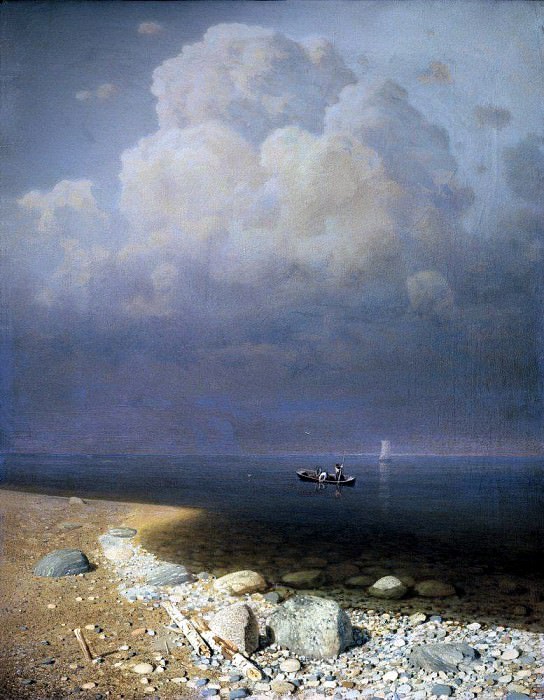Lake Ladoga. Arhip Kuindzhi (Kuindschi) (1842-1910)
Arhip Kuindzhi – Lake Ladoga.
Edit attribution
Download full size: 777×1000 px (0,1 Mb)
Painter: Arhip Kuindzhi (Kuindschi)
This painting was painted in 1873. Quindzhi spent the entire summer of 1872 on Valaam. The result was the appearance of this brilliant creation. The landscape is at a crossroads. On the one hand, it is a realistic understanding of nature. But at the same time you can still feel the characteristic influence of romanticism. The viewer can feel the romantic features in the foreground, which is deliberately highlighted by the light of the storm.
Description of Arkhip Kuindzhi’s painting "Lake of Ladoga".
This painting was painted in 1873.
Quindzhi spent the entire summer of 1872 on Valaam. The result was the appearance of this brilliant creation. The landscape is at a crossroads. On the one hand, it is a realistic understanding of nature. But at the same time you can still feel the characteristic influence of romanticism.
The viewer can feel the romantic features in the foreground, which is deliberately highlighted by the light of the storm. Kuindzhi was able to overcome in his work that overstrain with which to convey a special state of nature, which was inherent in the works of the late Romantics. The landscape is painted with a particular elegance. The shades of light are incredibly subtle. You can feel the incredible integrity, which completely removes the contrasts of light.
Quindzhi conveys impressions of Lake Ladoga. How quiet and majestic it is. The painter seeks to portray the stony bottom of the lake, which miraculously shines through the crystal clear water.
The painting "Lake Ladoga" opened the northern series of the famous painter’s works. For the artist the water space and the sky are of maximum importance. The space is built in a very interesting way. We feel how limitless it is. The same color scheme unites the lake and the sky. The color is incredibly rich and intense. The lake and the sky seem to merge into one. They completely merge into each other. The horizon, slightly catchy, is the only boundary between them.
But the boundaries are as conventional as possible, so you can fully feel the movement, the transition of one space into another.
The momentary moves intricately into the future. The sandy-gray clouds do not create a sense of gravity. They are balanced by the shore, composed of detailed stones.
The atmosphere of the thunderstorm is emphasized by the coolest possible range of blues and grays. The peculiar play of light and shade before the thunderstorm is simply amazing.
The landscape is philosophically contemplative.
Кому понравилось
Пожалуйста, подождите
На эту операцию может потребоваться несколько секунд.
Информация появится в новом окне,
если открытие новых окон не запрещено в настройках вашего браузера.
You need to login
Для работы с коллекциями – пожалуйста, войдите в аккаунт (open in new window).




















COMMENTS: 1 Ответы
Реально как фотка! Особенно камни, и брёвна!
You cannot comment Why?
In the middle ground, a small boat with two figures is visible on the water, adding a sense of scale and human presence to the vastness of the scene. Beyond the boat, a faint, ethereal white shape is present, possibly suggesting a distant cloud formation or another boat with sails.
The sky dominates the upper portion of the painting. Large, dramatic clouds, illuminated by an unseen light source, are the focal point, creating a sense of grandeur and possibly foreshadowing a change in weather. The contrast between the dark, moody blues of the sky and the bright white of the clouds is striking.
The subtext of the painting can be interpreted in several ways. The vastness of the lake and sky, contrasted with the tiny boat and figures, evokes themes of humanitys place in nature – small and perhaps vulnerable, yet also resilient. The dramatic clouds could symbolize the unpredictable nature of life or the grandeur and power of the natural world. The peaceful yet powerful imagery suggests a contemplation of existence, the sublime beauty of nature, and the introspection it can inspire. Theres a duality present: the calm of the water and the potential for storm in the sky, mirroring the contrasts within human experience.